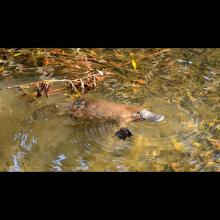Ornithorhynchus anatinus
Common name:
Duck-billed platypus
Genus:
Ornithorhynchus
Family:
Ornithorhynchidae
Suborder:
-n/a-
Ornithorhynchus anatinus
Common name:
Duck-billed platypus
Genus:
Ornithorhynchus
Family:
Ornithorhynchidae
Suborder:
-n/a-
Ornithorhynchus anatinus
Common name:
Duck-billed platypus
Genus:
Ornithorhynchus
Family:
Ornithorhynchidae
Suborder:
-n/a-
Family (Animalia): Ornithorhynchidae
The Ornithorhynchidae /ɔːrˌnɪθəˈrɪŋkɪdiː/ are one of the two extant families in the order Monotremata, and contain the platypus and its extinct relatives. The other family is the Tachyglossidae, or echidnas. Within the Ornithorhynchidae are the genera Monotrematum, Obdurodon, and Ornithorhynchus:
- Family Ornithorhynchidae
- Genus † Monotrematum
- †Monotrematum sudamericanum
- Genus † Monotrematum
- Genus †Obdurodon — an ancient branch of the platypus family
- †Obdurodon dicksoni
- †Obdurodon insignis
- †Obdurodon tharalkooschild
- Genus Ornithorhynchus
- Ornithorhynchus anatinus (the modern platypus)
Another two genera, Steropodon and Teinolophos, were originally thought to belong to the Ornithorhynchidae. However, they were both placed into a new family, the Steropodontidae. This decision was made based on differences in the dentary recovered from the Griman Creek Formation, Lightning Ridge, New South Wales, Australia. This dentary is the holotype for the genus Steropodon, thus the lack of information led to the original misclassification. Further research on Teinolophos has indeed shown it to be an animal much different from ornithochrynchids, lacking a beak, possessing a more complete mammalian dentition, and retaining primitive ears connected to the jaw as in more basal mammals.
The extinct Ornithorhynchus maximus has been included in Ornithorhynchus, but later placed with the echidna family Tachyglossidae as Zaglossus robustus.
Reference: Wikipedia

